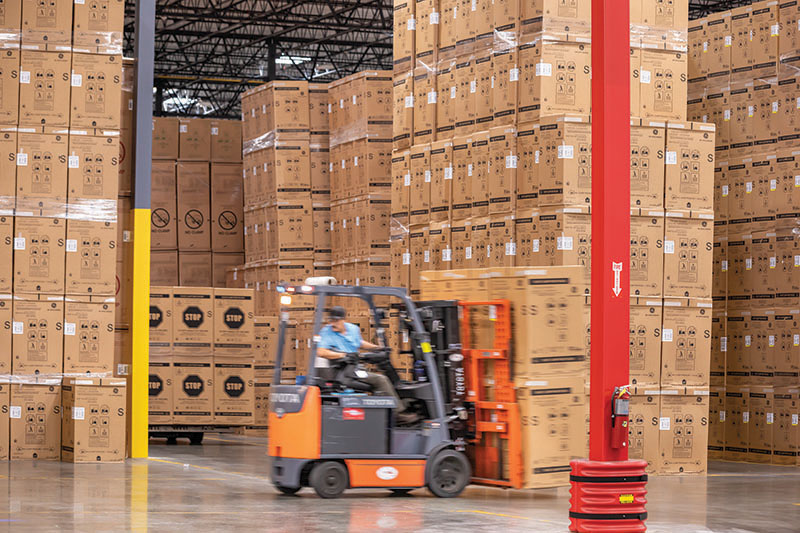System Report: GE Appliances pulls the digital thread
GE Appliances may not have taken all of the touches out of its distribution processes, but it has reduced them to a bare minimum, increased the velocity of product moving through its facilities and sped up training time. The key: A digital transformation with next-generation technologies like IoT, AI and VR.
The ideal materials handling is no handling at all. After all, every time you touch an item, it costs money. What’s more, in the home appliance space—think washers, dryers, refrigerators and the like—the more you touch an item, the greater the likelihood of damage to products that consumers expect in pristine condition.
Take an inside look into the redesigned GE Appliances’ distribution center.
Reducing the number of touches was one of the goals of a project undertaken about three years ago by GE Appliances, now owned by global appliance maker Haier. More importantly, GE Appliances set out to redesign its network, processes and technology stack to match the speed of a multi-channel, e-commerce world driven by consumer demands. “In our old world, we stacked product high and blasted it out in truckload or LTL quantities to our retail partners, or overnighted it to the contractor channel,” says Mark Shirkness, GE Appliances’ Louisville-based vice president of distribution.
Now, with more than 20 flavors of orders, who is placing the order is less important than a fulfillment process that can meet the requirements of all those different order types. “You can book an order for a 400-pound refrigerator on our site or one of our agents’ sites,” says Adam Wiseman, senior director of warehousing. “We might still ship out a full trailer or LTL, but we might put it on a plane today and then go final-mile for delivery tomorrow at a builder’s site or a high rise; we might put it on a pallet and ship it out FedEx Freight to someone’s house.”
The framework for the project included the following:
- Network rationalization reduced the number of distribution centers from eight core and approximately 15 satellite facilities to 10 core warehouses built for speed. “Our facilities are about 50% larger than in the past, but we’re getting double the output that we got in our old design,” says Wiseman. “That’s leverage.”
- A new building design is focused on reducing the number of touches and ramping up the velocity of movement through the facility, increasing the efficiency referred to above.
- Creating a digital thread, or the electronic genealogy of a product, that accelerates responsiveness
- Smart lift truck attachments, or basiloids, reduce damage and ensure the quality of the products being handled in the facility.
- Smart yard and control tower capabilities use a yard management system and RFID to provide real-time visibility of product in the yard and the facility; and
- Virtual reality identifies operator strengths on the front end of the hiring process and speeds up training once an operator is onboard.
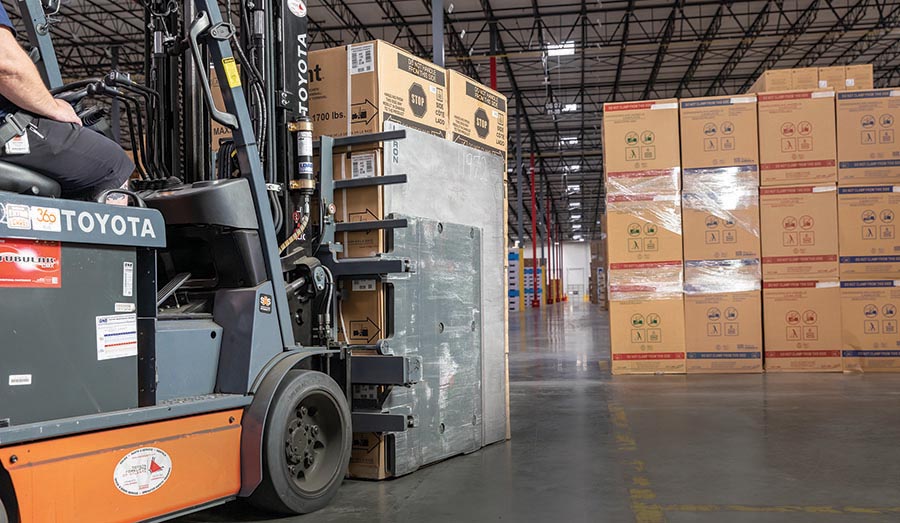
Given the size and weight of many of the home appliances handled in GE Appliances’ network, the materials handling systems are rudimentary. For instance, you won’t find much in the way of conveyor, sortation or other automated handling technologies, at least for now. Instead, yard dogs and lift trucks do the heavy lifting. But now, the whole network, including the individual facilities, yards and mobile equipment, is enabled by RFID (think IoT), Big Data and artificial intelligence. These deliver real-time visibility into the inventory in the yard and facility and ties that information, also in real time, to the demand for individual products.
While there are exceptions for seasonal and popular products, most inventory moves from the yard to an outbound truck within 24 to 36 hours of receipt. When the system identifies demand for an item coming off a truck, it is often crossdocked to an outgoing truck—essentially a one-touch supply chain; other inventory will go into a holding area for delivery in a day or two; or into floor storage areas for items that are frequently ordered or seasonal items. “Everything we do is based on what the customer is choosing,” says Shirkness. “We can go as fast as next day, but the bell curve is that most orders ship in three days.”
Reducing the amount of time a product is in the system, as well as the touches, also improves quality. “We know that exposure to touches is a leading indicator of damage,” notes Wiseman. “We want to wait up until the last moment to move a product and reduce those touches.”
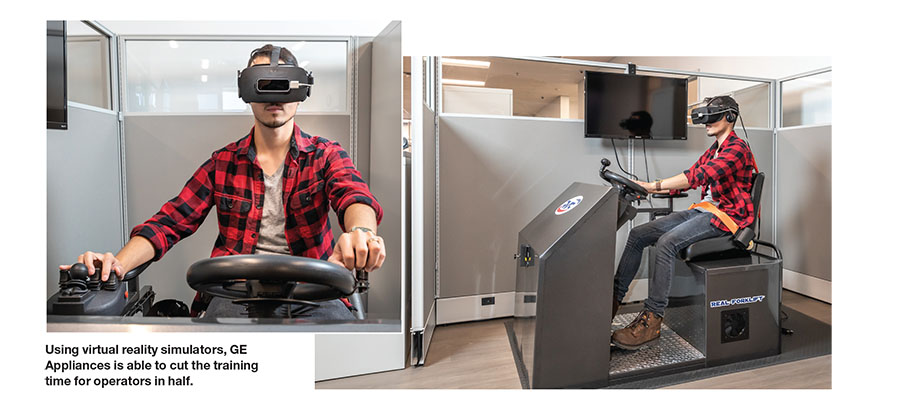
Building on history
GE Appliances is a storied name in the appliance industry. Its campus in Louisville, Ky., has long been a leader in appliance manufacturing. And, notes Shirkness, who has been with the company for 33 years, logistics is one of the company’s competitive advantages. “Going back to the 1960s, we served two channels: retail and the contractor market,” he says. “The retail world was classic full truck shipments from a warehouse to a warehouse. But very early on, we developed final-mile delivery capabilities where we could land an order at a builder’s job site. For years, our go-to-market strategy was driven by what we believe are market-leading distribution capabilities.” He adds that GE Appliances is the leader in the contractor/builder channel.
While GE Appliances has been looking at the new world of distribution for some time, the major change for the company came in 2016, following the acquisition by Haier. “Haier challenged us to begin thinking differently about how we operate in order to be No. 1 in the United States,” Shirkness says.
Sales grew, but the supply chain tread water. “If sales grew by 10%, then our distribution needs grew by 10%,” Wiseman says. “We weren’t getting any leverage. That’s when we realized that our old way of doing business was not a recipe for growth.”
Plans for reconfiguring the network and bringing in new technologies got underway in 2017. The distribution organization had three guiding principles.
- Build on the history of what got them there in the first place, which was GE Appliances’ leadership role in final-mile delivery.
- Build dexterity in warehouse operations to meet new multi-channel fulfillment modes.
- Get leverage in the network. “We added 50% more space to some of our buildings, but we got a 100% increase in productivity,” Shirkness says. “That’s leverage.”
There was one other principle, which Shirkness likens to Moore’s Law for distribution. “We wanted to accelerate the learning curve for operators by using virtual reality to cut the training time in half,” he says (see page 26). “And, we wanted to cut our touches in half to improve quality. We now live in a world of halves, halves, halves. That’s how the elements come together for this new ecosystem.”
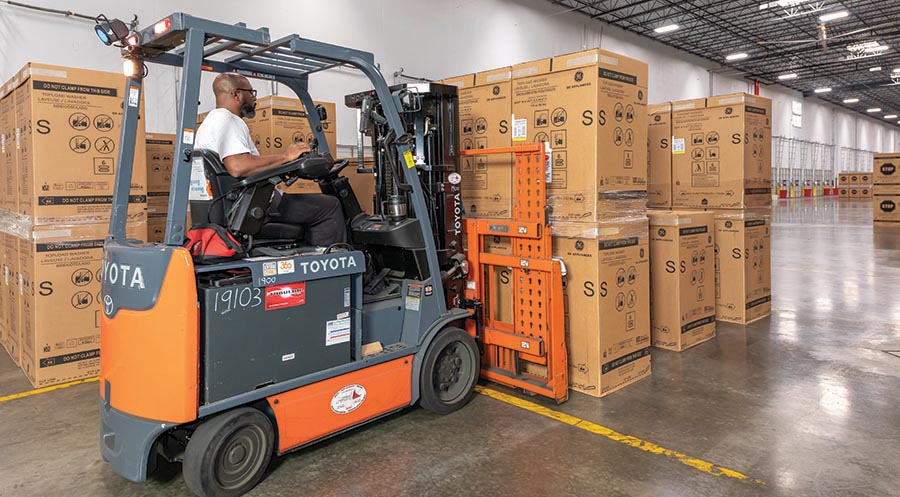
Product that will be shipped out within 24 to 36 hours is staged near the dock.
The new ecosystem
A number of components came together to enable the transformation of GE Appliances’ distribution capabilities. One of the most important was the rationalization of the network. As recently as 2011, the company had nine distribution centers. Over the ensuing years, the company inherited some distribution centers and added satellite facilities that brought the network to 15. When a facility under construction in California is complete, “we will be at 10 core warehouses that have been rationalized and built for our current needs,” says Wiseman.
The rationalization of the network wasn’t just about the location of the facilities; it also involved a redesign of the facilities and the yard to ramp up efficiency. They are larger in size, but more importantly, the new design has significantly increased the size of the yard surrounding the DC, integrating yard management into the flow of product through the facilities. Shirkness calls the use of the yard “an intentional pause.” Here’s what he means.
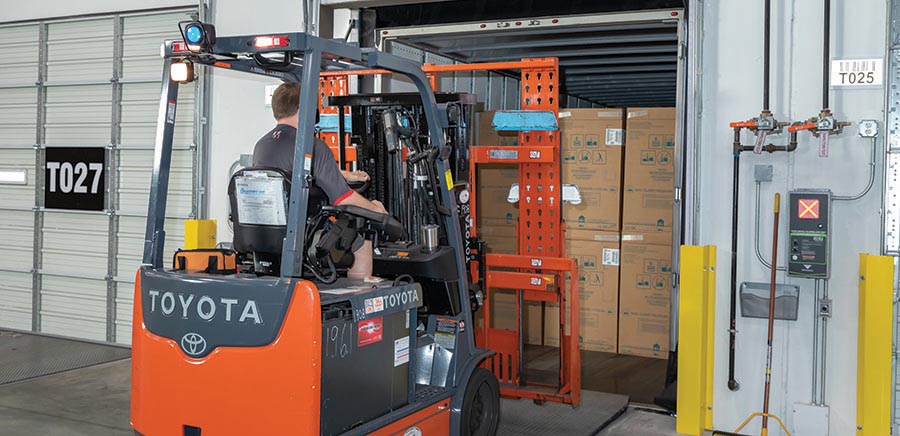
Product that will be shipped out within 24 to 36 hours is ready to be loaded onto an outbound truck.
The old facilities were essentially classic warehouses: When product arrived, trailers and containers were moved to the dock, product was unloaded and then stored until it was time to fill an order. “We pushed things into the warehouse, we managed by first-in/first-out (FIFO), and we didn’t talk about turns, velocity or speed,” says Wiseman.
In the new facilities, GE Appliances increased the size of the yard and implemented a yard management system to provide control tower visibility into inventory inside and outside the facility. The yard provides “the intentional pause” referred to by Shirkness. By staging inventory before moving a trailer into a receiving dock, GE Appliances can wait to make a decision about the disposition of that product until there is demand. A trailer may “pause” in the yard, but once it moves to a receiving dock, the product moves quickly. That also speeds up efficiency.
The People Factor
Virtual reality, or VR, is one of the next-generation technologies that GE Appliances is implementing as part of the re-design of its processes. The technology is now core to an approach to recruiting and retention that Mark Shirkness, vice president of distribution, describes as “attitude, aptitude and altitude.” You have to have an attitude: Skills for handling pallets, cartons and eaches will often transfer from one DC to the next, but handling large and heavy appliances that need to look perfect is a different animal. “Picking a refrigerator 30 feet in the air can be a little unnerving,” says Shirkness. “To do that, you have to have an attitude.” So, GE Appliances uses VR as an employee screening method.
During the application and selection period, potential associates sit in a VR trainer to get a feel of what they’ll be asked to do and to see if they have the attitude to do the job. You have to have aptitude: GE Appliances has a formal education and certification program known internally as The University. “There are a number of modules that an associate goes through to demonstrate their skills and earn certification,” says Adam Wiseman, senior director of warehousing. “The modules are scored and supervisors can see where someone missed points. That allows supervisors to address an issue before an appliance gets damaged.” Altitude, or how high can you fly: Altitude asks the question: How great can you be? GE Appliances wants to retain associates by providing opportunities for operators to improve their skills and the tasks they can take on in the DC. “In our facilities, we reference our people as craftsmen,” Shirkness says. “If you want to be a captain of an airline, you have to demonstrate the ability to fly a jet through a hailstorm. You do that in a simulator.” He adds that top loading a refrigerator or loading one unit on top of another in a trailer, is the GE Appliances’ equivalent of flying through a hailstorm.
Operators who want to qualify for that highly skilled work train and then demonstrate their ability in the simulator. VR is still a new tool at GE Appliances. Shirkness says that it’s an investment the company is making in its people and the ROI will be determined in the future by recruitment and retention outcomes in the facilities.
Trailers and containers in the yard are tracked in real time by RFID; the yard is further connected to a control tower in Louisville where traffic controllers monitor every asset and across the network. As orders come in, the traffic controllers orchestrate the movement of assets and inventory from the yard to the facility and onto the shipping dock. When it comes to the processes inside the DC, GE Appliances refers to the design as symmetrical warehousing: If you sliced the DC down the middle, the two sides are mirror images of one another. “If a washing machine coming off a truck needs to go out today, we take it to a door on the A side of the building,” Shirkness says. “If we don’t need it until tomorrow, we’ll stage it in a velocity area on the B side of the building. If we need it later in the week, we put it in another location in the building.” Frequently ordered items are stored five high near the docks. The GE Appliances warehouse management system (WMS) is always looking for the next best move for the lift truck operator in a form of task interleaving. That goes a good way toward the increased productivity in the building. “This is how we get the leverage and transformation of the warehouse,” Shirkness says. There’s also a quality play here: Handling appliances is different from handling a carton in a traditional DC. It can take six to nine months to master the handling of the equipment. Simulating the operating environment with virtual reality as a training tool is a step toward speeding up the training process. At the same time, GE Appliances added technologies that make operating a fork truck more like driving a car. Equipment is loaded with backup cameras, and sensors on the basiloid clamp attachments alert an operator who is putting too much pressure on an appliance. Laser-guided site lines assist operators as they move and store product. Last, GE Appliances worked with lift truck manufacturers to develop new gear systems for forward and backward movement. “We’ve gotten extremely creative with forward and reverse,” says Wiseman.
Pulling the digital thread
Big Data and artificial intelligence inform the decisions made by the traffic controllers and the WMS. GE Appliances refers to this as “the digital thread,” and it is key to accelerating the responsiveness of the overall supply chain.
The digital thread is essentially the genealogy of any given appliance. GE Appliances begins building that genealogy during the manufacturing and transportation of any given product. “We have a data lake where we can crunch about 3 billion lines of data,” says Shirkness. “When any appliance shows up in the network, we know it’s lifecycle up to that point.”
Once a product is in the network, the digital thread, RFID tracking systems, the yard management and warehouse management systems, the control tower and the order book all come into play to enable decision-making as late in the game as possible. Shirkness says that starting in 2016, his team spent an enormous amount of time learning best practices from other industries, such as the automotive industry, that had become experts in postponement strategies. “Our vision is that if I scan a washing machine when I take it off the trailer, the system can identify who needs that appliance at any given moment in time,” he says. “That could be a customer who ordered it 10 minutes ago and needs it to go out tonight or could be an order that doesn’t ship for 36 hours.”
The next evolution
The system just described is phase one of GE Appliances’ distribution evolution. Phase two is in development. Among the items on the “to do” list are a new type of printed RFID tag that uses a proprietary ink, developed at the University of Louisville, from Pascal Tags. Instead of dedicated RFID handhelds and portals, the tags can be printed on demand, and charged by and read by existing Wi-Fi access points.
Also on the lineup is machine learning tied to a transportation execution system. “Right now, we have a lot of individuals working in the control tower to make transportation decisions and resolve issues, like when a truck leaves late,” says Shirkness. “We want to evolve to a transportation execution system that utilizes AI and machine learning to automate some of those activities.” Shirkness says he will still need decision makers to solve the big problems, but going back to the theory of halves, there will be fewer.
The results of the last two years of work are that GE Appliances is a network that is more responsive to the customer. “In the past, we could be fast and reliable on our terms—shipping to specific locations under specific times and circumstances,” says Shirkness. “Now, we can be fast and reliable on the customer’s terms, whether it’s shipping one or 100 appliances, or whether we’re shipping to a warehouse, a store, a job site or your house.”
“That’s how we’re going to continue to create our competitive advantage,” he says

Article Topics
Software News & Resources
C-suite Interview with Keith Moore, CEO, AutoScheduler.AI: MODEX was a meeting place for innovation C-Suite Interview with Frank Jewell of Datex, Leading the Way in the Material Handling Industry Give your warehouse management systems (WMS) a boost Agility Robotics and Manhattan Associates partner to bring AI-powered humanoid robots into warehouses Siemens, Universal Robots, and Zivid partner to unveil smart robotic picking solution OTTO Motors showcases latest software release for optimizing floor space Rite-Hite ONE digital platform debuts More SoftwareLatest in Materials Handling
Registration open for Pack Expo International 2024 Walmart chooses Swisslog AS/RS and software for third milk processing facility NetLogistik partners with Vuzix subsidiary Moviynt to offer mobility solutions for warehouses Materials Handling Robotics: The new world of heterogeneous robotic integration BSLBATT is looking for new distributors and resellers worldwide Lucas Watson appointed CSO for Körber’s Parcel Logistics business in North America Hyster recognizes Dealers of Distinction for 2023 More Materials HandlingAbout the Author
Subscribe to Materials Handling Magazine

Find out what the world's most innovative companies are doing to improve productivity in their plants and distribution centers.
Start your FREE subscription today.
April 2024 Modern Materials Handling

Latest Resources


